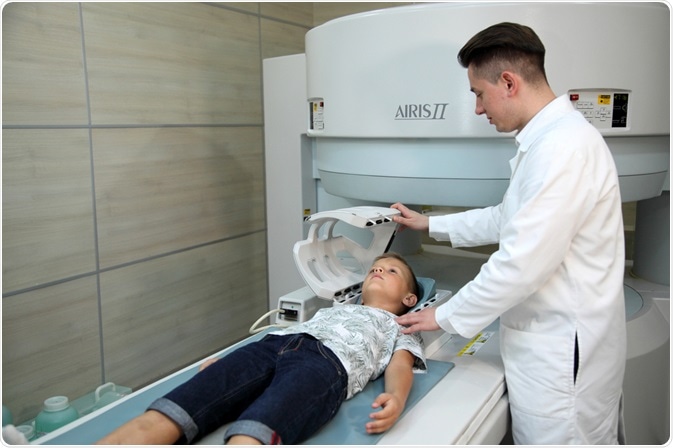Second, to leukemia, a pediatric brain tumor is the most common form of malignancy in children.
Studies have identified that certain normal brain cells, which appear much earlier than they are expected in fetal development, undergo neoplastic transformation to develop malignant brain tumors later in life.

Image Credit: MASTER VIDEO/Shutterstock.com
What is a childhood brain tumor?
Childhood brain cancers are usually classified according to the site of origin, or the age of diagnosis. Based on the site of origin, brain cancers are of two types: supratentorial or infratentorial tumors.
Based on the age of diagnosis, congenital brain tumors (diagnosed within 60 days of life) and infant brain tumors (diagnosed before age of 1 year) are the most commonly classified ones.
The incidence of childhood brain cancer varies from 1 – 5 per 100,000 children worldwide, with the highest prevalence in the United States. The prognosis of childhood brain cancer is very poor, with an overall survival rate of less than 30%. Such a poor prognosis is mainly associated with the type of malignant lesion, size and location of the tumor, and therapeutic side effects.
The most common form of childhood brain tumor is medulloblastoma, which occurs before the age of 10 years. Medulloblastomas develop in the cerebellum and are highly heterogeneous.
According to the World Health Organization classification of brain tumors, 4 types of medulloblastomas have been identified: wingless, sonic hedgehog, group 3, and group 4.
What are the risk factors for childhood brain tumors?
Both genetic and environmental factors are responsible for the development of childhood brain tumors. Having a family history of brain tumors increases the chance of cancer development.
Another vital risk factor is parental age; studies have shown that babies born to mothers who are older than 40 are at higher risk of developing astrocytoma and ependymoma.
Children with leukemia who receive a high dose of radiation are also at higher risk of developing brain cancer. In addition, there is a correlation between childhood exposure to infections and the risk of brain cancer development.
How does cancer develop?
The transformation of normal cells into cancerous cells occurs due to aberrant cellular signaling, which leads to increased cell growth and migration and reduced cell death. In simple terms, certain cells gain the capacity to escape cellular signaling pathways that control or maintain the balance between cell growth and death.
Genetic mutations are the main reason behind the neoplastic or cancerous transformation. The most frequently mutated genes are those controlling cell proliferation, such as genes that encode growth factors. In addition, genes that trigger cell death pathways (tumor suppressor genes) undergo mutations that make them inactive.
How does childhood brain cancer develop?
Despite being the leading cause of non-accidental death in children, the mechanism of the childhood brain cancer development and progression is still unclear.
In this context, a recent study using mouse models has identified certain normal cells that are believed to undergo the neoplastic transformation process and develop childhood brain cancers. These cells initially appear in the embryonic development stage much earlier than they are expected.
The cerebellum in the brain is the most common location of childhood brain cancer. The investigation of more than 30 types of cells in the mouse cerebellum has led to the identification of certain normal cells that are predisposed to neoplastic transformation.
To get more information about the biological nature of these cells, the study has employed single-cell sequencing technology that allows in-depth analysis of individual cells.
The study findings have revealed that specific cell populations are involved in developing different types of childhood brain cancers. For example, Sonic Hedgehog medulloblastoma, group 3 medulloblastoma, and group 4 medulloblastoma transcriptionally resemble granule cells, Nestin+ stem cells, and unipolar brush cells of the cerebellum, respectively.
In addition, it has been found that large tumors contain diverse cell populations with diverse differentiations. This indicates the highly complex and heterogeneous nature of childhood brain tumors.
The series of events responsible for the onset of cancer can start occurring in humans at six weeks in the uterus. This indicates that the process of developing brain tumors can be initiated long before the tumors are diagnosed clinically.
Another very interesting study has revealed that genetic mutations that are responsible for childhood brain cancer development occur in the very early stages of fetal development. The study has identified specific cell populations in the pons and forebrain (brain areas where high-grade brain tumors develop) that undergo growth arrest rather than developing normally. These cells are ultimately transformed into cancerous cells.
How can the new findings benefit children with brain cancer?
The knowledge about the mechanism of brain cancer development can impact medical science in many ways. In addition to better understanding the nature of childhood brain tumors, these findings are useful in differentiating the normal healthy cells from the cell populations that are susceptible to cancerous transformation.
The investigation of the physiological properties of the variety of cells within a single tumor can open up new paths toward the development of new therapeutic interventions.
Last Updated: Apr 14, 2020